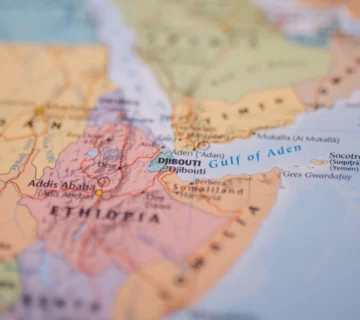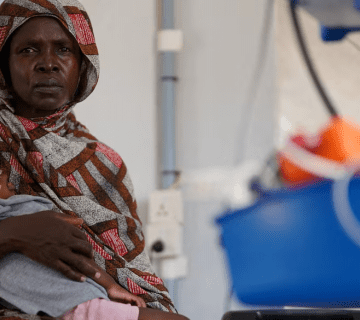The LAPSSET Corridor Project is the first single largest, integrated, transformative and game-changing infrastructure project the Government of Kenya has initiated and prepared under Vision 2030 Strategy Framework without external assistance. The project endeavors to deliver a just and prosperous middle-income Kenya by the year 2030. Kenya is spearheading the development of Lamu Port-South Sudan-Ethiopia-Transport (LAPSSET) Corridor Project to strengthen her position as a gateway and a transport and logistics hub to the East African sub-region and the Great Lakes region to facilitate trade, promote regional economic integration and interconnectivity between African countries. The LAPSSET project was estimated at USD 24.5 Billion, equivalent to Ksh. 2.4 trillion at the time.
Out of the seven LAPSSET components, the Government of Kenya has put priority on the development of the First Three Berths and Associated Port Infrastructure, which is expected to trigger the development of the other components.
Benefits of the LAPSSET corridor project
The LAPSSET Corridor Project covers over half of the country with a planned investment resource equivalent to half of Kenya’s Gross Domestic Product (GDP) for the core investment alone. Conservative feasibility statistics show that the project will inject between 2 per cent to 3 per cent of GDP into the economy. It is also estimated that the contribution of the LAPSSET Corridor Project to the country’s economic growth could range between 5 per cent and 8 per cent of GDP when generated and attracted investments finally come on board. This view is supported by the fact that new investments of the magnitude of LAPSSET Corridor Project in hitherto underdeveloped areas usually yield higher growth figures.
Such an investment will provide equity in development for the entire country in line with the Constitution and the Kenya Vision 2030. It will further enhance efficient, seamless inter-modalism in the country’s transport and logistics operations while the planned resort cities will resolve the current urban primacy scenario centered along the current Northern Corridor route from Mombasa – Nairobi – Malaba, and Kisumu – Busia. Overall, the development of the LAPSSET Corridor will create employment and reduce poverty in the country as well as improve accessibility and enhance the socio-economic development of the northern part of the country. Some of the key benefits are outlined below.
First, LAPSSET will activate seamless interconnectivity within coastal counties, throughout the country and linkages to neighboring countries through the country’s roads, railway, ports, airports, and telecommunications. It will strengthen Kenya’s regional Hub status in Eastern Africa as a result of the country being the originator of transboundary transport projects, special economic zones, and Free Trade Areas. This will help the region create capacity in infrastructure industry from human, technological, financial and consumers in the country. Countries like China, India, Malaysia, Brazil, Iran, and Singapore among others have used this model to adopt technology and train their manpower while building capacity in their delivery institutions. Indeed, continued investment in infrastructure has seen the country recover resulting in a jumpstart from a marginal 1.6 per cent to 2.6 per cent previously to 5.5 per cent growth in 2008, 2009 and 2010 respectively.
Second, the project will open up the pastoral regions particularly in the north of Kenya that will become the next growth frontier for the entire economy and facilitate socio-economic development. This will be enhanced by an increase in electric power generation through various energy initiatives such as green energy and clean energy to improve reliability in electric power supply to support faster rate of industrialization and inter-country electricity supply such as the envisaged Kenya-Ethiopia electricity power agreement.
Third, the potential to attract increased private sector investment in infrastructure development and management in the country cannot be overemphasized. Currently, there are a number of private sector involvements, particularly in the energy, water and railway sub-sectors. More private sector investments are being explored in roads, railways, ports and water services.
Finally, by helping the region establish efficient, reliable and sustainable infrastructure, there will be accelerated creation of more employment opportunities in both specialized areas and labor thus leading to a reduction of poverty levels in the country and the region.
Protecting the LAPSSET Infrastructure
An infrastructural project the size of LAPSSET, covering hundreds of kilometers of road, rail oil pipeline and power transmission lines together with all the complimentary support infrastructure require huge investments in security architecture. These include urban centers, power lines, and water projects. Light industries are also expected to crop up along the corridor. In this article, we look at the threat in two dimensions: Threats created by the project and threats to the project.
Threats by Project
The project runs mainly on land except for the terminal Port of Lamu. It will cause demographic displacements, alteration of lifestyle, urbanization, pollution including possible oil spills, the environmental impact of heavy construction, distortion of wildlife corridors and many other disruptions to the otherwise quiet region.
Threats to the Project
The region of Kenya through which the LAPSSET is designed to pass through is largely an open semi-arid Savanna which is sparsely populated. It is home to various nomadic communities and is to a larger extent ungoverned territory. The project, therefore, will be vulnerable to attacks by terrorists, criminal gangs, saboteurs and even the local nomadic communities if it is viewed as an interruption to their nomadic lifestyle – or it cuts them off from pasture and water.
The whole infrastructure needs to be totally secured continuously and effectively. The population living along and within the adjacent areas of the infrastructure need to be securitized, educated and made to benefit from the project before, during and after the construction. All other affected, including the wildlife and environment, must be factored in the planning in order to forestall any negative effects that may arise.
Such a huge infrastructure or installation needs an integrated approach to security. Physical security measures must be inbuilt in the project to deter easy access by unauthorized persons. Seamless surveillance from terminal to terminal through electronic, human and aerial means. Incorruptible screening methods for both people and goods must be deployed at every terminal and any other sub-stations along the way. Efficient security intelligence is a key ingredient of the total security architecture. In other words, there must never be gaps allowed any time anywhere. It is to be noted that the institution with an inherent capability to secure such a huge infrastructure is the Kenyan military.
Having noted that military standard of defence is required to secure the LAPSSET, then the military should in its Strategic Defence and Security Review (SDSR) include the LAPSSET defence in collaboration with other security organs and forces. This would, in essence, address static peacetime bases and posture of specialized military units in order to effect proactive deployment. It would also be prudent to seek a blanket authorization by parliament for KDF to conduct military operations in the country should need to arise in defense of the LAPSSET.
In conclusion, the LAPSSET project offers great transformational potential not only to the Kenyan economy but also to the economies of the region. Yet, its design, architecture, future viability, and its strategic importance requires a security framework that involves military standard defense assessments as well as civilian government’s prioritized support.
By Brig Gen (Rtd) George G.Kabugi is a Defence and Security expert at the HORN Institute



